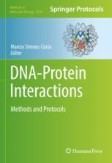Search
Search Results
-
Acridinium-Based Chemiluminescent Receptor-Ligand Binding Assay for Protein/Peptide Hormones
Chemiluminescent acridinium esters (AE) have been extensively used for oligonucleotide probing and peptide-binding assays in molecular research due...
-
Detection of Protein–Protein Interactions Using Glutathione-S-Transferase (GST) Pull-Down Assay Technique
Pull-down assay is a technique to analyze direct protein–protein interaction under in vitro condition. Also, this technique is appropriate for...
-
Bimolecular Fluorescence Complementation (BiFC) Assay to Visualize Protein–Protein Interactions in Living Cells
Bimolecular fluorescence complementation (BiFC) assay is a method to visualize the protein–protein interaction in living cells. This technique is...
-
Bimolecular Fluorescence Complementation Assay to Evaluate HSP90-Client Protein Interactions in Cells
Protein–protein interactions (PPI) in cells play a pivotal role in cellular function and dynamics. Cellular proteostasis is maintained by PPI...
-
Isolation and Immunodetection of Enzymatic DNA–Protein Crosslinks by RADAR Assay
DNA–protein crosslinks (DPCs) are steric hindrances to DNA metabolic processes and the removal and repair of DPCs is a rapidly evolving area of...
-
Measuring Protein–Protein Interactions in Cells using Nanoluciferase Bioluminescence Resonance Energy Transfer (NanoBRET) Assay
Protein–protein interactions (PPIsProtein-protein interactions (PPIs)) are increasingly recognized for their roles in functional cellular networks...
-
In Vivo Assessment of Protein-Protein Interactions Using BRET Assay
Proteins play an important part in almost all life activities and across all organisms. Proteins occasionally act on their own but rather fulfill...
-
DNA–Protein-Interaction (DPI)-ELISA Assay for PPAR-γ Receptor Binding
Dysregulation of peroxisome proliferator-activated receptor (PPAR)-γ has been described in a plethora of pathological conditions, such as diabetes,...
-
In Vitro Flagellar Type III Protein Transport Assay Using Inverted Membrane Vesicles
The flagellar axial proteins are transported across the cytoplasmic membrane into the central channel of the growing flagellum via the flagellar...
-
Branched Proximity Hybridization Assay for the Quantification of Nanoscale Protein–Protein Proximity
To better quantify the nanoscale protein–protein proximity, we developed a new branched proximity hybridization assay (bPHA). In this assay,...
-
Optimized Microscale Protein Aggregation Suppression Assay: A Method for Evaluating the Holdase Activity of Chaperones
Many molecular chaperones act as holdases by binding hydrophobic regions of substrates to prevent aggregation. Therefore, measuring holdase activity...
-
Quantification of putative ovarian cancer serum protein biomarkers using a multiplexed targeted mass spectrometry assay
BackgroundOvarian cancer is the most lethal gynecologic malignancy in women, and high-grade serous ovarian cancer (HGSOC) is the most common subtype....

-
An electrophoretic mobility shift assay using the protein isolated from host plants
BackgroundThe electrophoretic mobility shift assay (EMSA) is a common technology to detect DNA-protein interactions. However, in most cases, the...

-
Screening of Buffers and Additives for Protein Stabilization by Thermal Shift Assay: A Practical Approach
Thermal shift assay (TSA), also commonly designed by differential scanning fluorimetry (DSF) or ThermoFluor, is a technique relatively easy to...
-
Evaluation of portable refractometr as an alternative method to biuret assay for measurement of serum total protein in horse
The measurement of serum total protein (TP) is commonly performed by the biuret method. Refractometery which is less expensive and faster method also...

-
MitoLuc: A Luminescence-Based Assay to Study Real-Time Protein Import into Mitochondria
All but a few mitochondrial proteins are translated into the cytosol and imported in via complicated and varied pathways. These processes occur over...
-
Microscale Thermophoresis Assay: A Powerful Method to Quantify Protein–Nucleic Acid and Protein–Protein Interactions
Plant viruses are among the most disastrous pathogens that cause enormous losses in crop yield and crop quality, threatening food security worldwide....
-
A Simplified Method to Assay Protein Carbonylation by Spectrophotometry
Protein carbonylation is an irreversible oxidation process leading to a loss of function of carbonylated proteins. Carbonylation is largely...
-
A DNA Pull-Down Assay with Diversity Forms of Competitor for Detecting or Evaluating Protein–DNA Interactions
DNA–protein interactions (DPIs) are critical to all living organisms, particularly in the regulation of gene expression, replication, packing,...
-
A Powerful Method for Studying Protein–Protein Interactions in Plants: Coimmunoprecipitation (Co-IP) Assay
With the continuous application of molecular biology technologies in the field of plant virology, growing evidence shows that the interactions...
